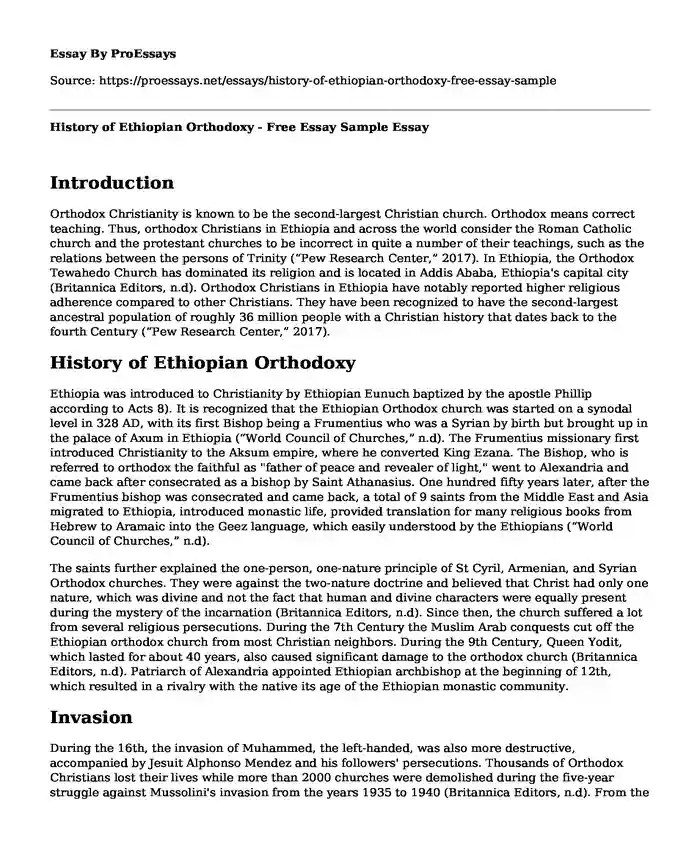Introduction
Orthodox Christianity is known to be the second-largest Christian church. Orthodox means correct teaching. Thus, orthodox Christians in Ethiopia and across the world consider the Roman Catholic church and the protestant churches to be incorrect in quite a number of their teachings, such as the relations between the persons of Trinity (“Pew Research Center,” 2017). In Ethiopia, the Orthodox Tewahedo Church has dominated its religion and is located in Addis Ababa, Ethiopia's capital city (Britannica Editors, n.d). Orthodox Christians in Ethiopia have notably reported higher religious adherence compared to other Christians. They have been recognized to have the second-largest ancestral population of roughly 36 million people with a Christian history that dates back to the fourth Century (“Pew Research Center,” 2017).
History of Ethiopian Orthodoxy
Ethiopia was introduced to Christianity by Ethiopian Eunuch baptized by the apostle Phillip according to Acts 8). It is recognized that the Ethiopian Orthodox church was started on a synodal level in 328 AD, with its first Bishop being a Frumentius who was a Syrian by birth but brought up in the palace of Axum in Ethiopia (“World Council of Churches,” n.d). The Frumentius missionary first introduced Christianity to the Aksum empire, where he converted King Ezana. The Bishop, who is referred to orthodox the faithful as "father of peace and revealer of light," went to Alexandria and came back after consecrated as a bishop by Saint Athanasius. One hundred fifty years later, after the Frumentius bishop was consecrated and came back, a total of 9 saints from the Middle East and Asia migrated to Ethiopia, introduced monastic life, provided translation for many religious books from Hebrew to Aramaic into the Geez language, which easily understood by the Ethiopians (“World Council of Churches,” n.d).
The saints further explained the one-person, one-nature principle of St Cyril, Armenian, and Syrian Orthodox churches. They were against the two-nature doctrine and believed that Christ had only one nature, which was divine and not the fact that human and divine characters were equally present during the mystery of the incarnation (Britannica Editors, n.d). Since then, the church suffered a lot from several religious persecutions. During the 7th Century the Muslim Arab conquests cut off the Ethiopian orthodox church from most Christian neighbors. During the 9th Century, Queen Yodit, which lasted for about 40 years, also caused significant damage to the orthodox church (Britannica Editors, n.d). Patriarch of Alexandria appointed Ethiopian archbishop at the beginning of 12th, which resulted in a rivalry with the native its age of the Ethiopian monastic community.
Invasion
During the 16th, the invasion of Muhammed, the left-handed, was also more destructive, accompanied by Jesuit Alphonso Mendez and his followers' persecutions. Thousands of Orthodox Christians lost their lives while more than 2000 churches were demolished during the five-year struggle against Mussolini's invasion from the years 1935 to 1940 (Britannica Editors, n.d). From the year 1950to date, the Ethiopian orthodox church became autocephalous where it’s no longer relied on the authority of external patriarch to make appointments. Under the Amhara dominated Ethiopian monarchy, the Ethiopian orthodox church as then declared as the state church in Ethiopia during the regime of Emperor Haile Selassie (Britannica Editors, n.d). Despite the persecutions the Ethiopian orthodox church underwent in several authorities, it remained its most influential religion. To date, each community in Ethiopia has its church school, which teaches theological seminars and has been the sole source of Ethiopian education and with more than 0million adherents in the 21st Century (“World Council of Churches,” n.d).
Conclusion
From the text discussed, it's clear that Ethiopian orthodoxy has come a long way. Its current administrative structure is better than the old one and has been most conducive for the clergy. Despite the many disagreements, rivalries, and persecutions by authorities, the church has remained the most influential and dominant religion in Ethiopia.
References
Britannica Editors. (N.d). Ethiopian Orthodox Tewahedo Church. Britannica. https://www.britannica.com/topic/Ethiopian-Orthodox-Tewahedo-Church
Pew Research Center. (2017, November 08). Orthodox Christianity in the 21st Century. Pew Research Center. https://www.pewforum.org/2017/11/08/orthodox-christians-are-highly-religious-in-ethiopia-much-less-so-in-former-soviet-union/
World Council of Churches. (N.d). Ethiopian Orthodox Tewahedo Church. World Council of Churches. https://www.oikoumene.org/en/member-churches/ethiopian-orthodox-tewahedo-church.
Cite this page
History of Ethiopian Orthodoxy - Free Essay Sample. (2023, Dec 12). Retrieved from https://proessays.net/essays/history-of-ethiopian-orthodoxy-free-essay-sample
If you are the original author of this essay and no longer wish to have it published on the ProEssays website, please click below to request its removal:
- Biography of Charlotte Perkins
- Leonardo da Vinci and Harper Lee Essay Example
- Comparison of Roman Catholicism and Buddhism Essay
- Essay Sample on Industrialization's Impact on Environment: The Global Challenge of Contaminants
- Essay Example on Phenomenal Nancy Pelosi, America's Most Powerful Woman Speaker
- African American and Native American History - Free Essay Sample
- Free Report: Assessing Ram's Eligibility for Canadian Permanent Residence in the Self-Employed Category







